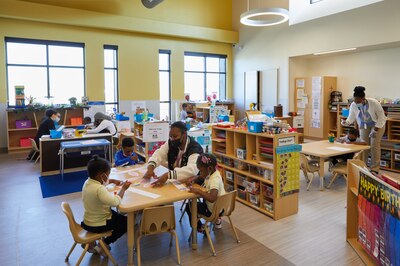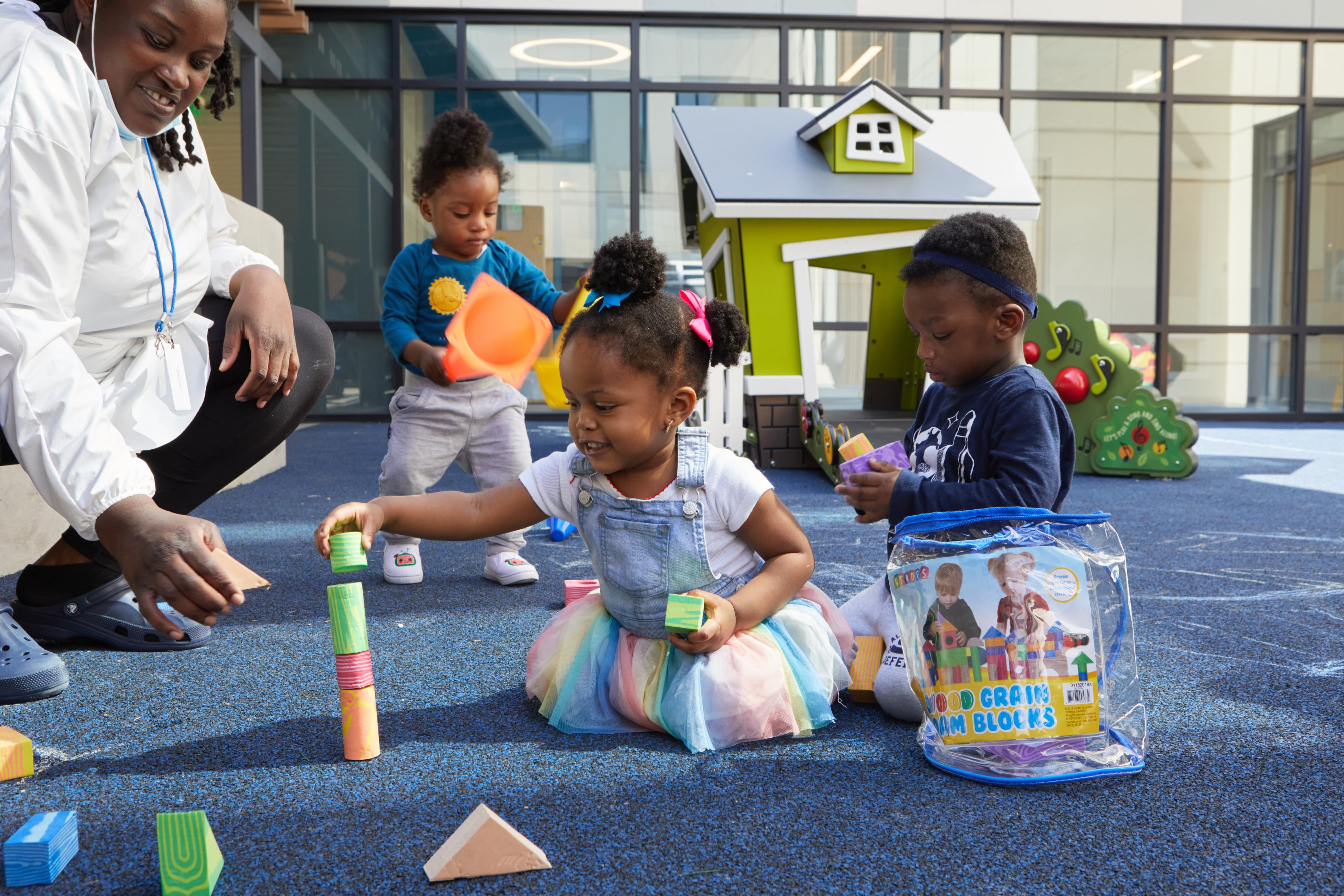Sign up for Chalkbeat Newark’s free newsletter to keep up with the city’s public school system.
At Clinton Hill Early Learning Center in the South Ward, everything is designed with the city’s youngest children in mind:
Many of the wall decorations are just 2 feet off the ground — the perfect view for infants and toddlers. The lobby overflows with plants and sunlight, the classrooms are filled with color, and the courtyard has climbing structures, toys, and, most importantly, padded flooring.
Clinton Hill Early Learning Center offers one solution for closing gaps in financing early childhood education. The center is funded by the Maher Charitable Foundation, a philanthropy that engages in early childhood education projects and policy efforts and has previously funded the expansion of Newark early learning facilities.
Maher built the $17 million Clinton Hill Early Learning Center, working closely on construction plans with community organizations Clinton Hill Community Action, Clinton Hill Community & Early Childhood Center Inc., and La Casa de Don Pedro. The three groups now share the responsibility of running the center day-to-day.
That partnership is helping provide some Newark families with access to state-of-the art programming and facilities at a time when infant and toddler care nationwide is both expensive and limited.
During the height of the COVID pandemic, federal funding helped to keep care centers operational. Now that money has expired, leaving many early childhood education and care centers struggling to stay open.
Khaatim Sherrer El, executive director of Clinton Hill Community Action, said the center’s goal from the beginning was to act as an example of what’s possible for Newark.
“We didn’t want to signal that we’re trying to put anybody out of business,” said Sherrer El. “We want to demonstrate what the children of Newark deserve.”
Early learning providers struggle without pandemic aid
The need for child care for Newark’s youngest children is great. The group Advocates for the Children of New Jersey reported that, as of March 2022, there was space for only about 18% of Newark’s infants and toddlers in the city’s programs.
Cynthia Rice, senior policy analyst for ACNJ said programs for infants and toddlers are both the most expensive to provide and historically underfunded. Now, the problem is getting worse.
“During and after COVID, the American Rescue Plan helped programs keep their doors open. But now, that money is gone. It had to be gone by Sept. 30,” said Rice.
Rice said the COVID-era relief funding primarily helped pay for staffers’ salaries. But without additional funds, early childhood programs are struggling to pay the number of employees necessary for infant and toddler care.
“You have one adult for every four babies. That’s what our regulations require, so it’s a lot more expensive than preschool,” Rice said.
The Century Foundation is calling the ending of the American Rescue Plan the “child care cliff” and predicts it will have severe consequences as child care programs adjust to the lack of funding. They expect that nationwide an estimated 3.2 million children will lose access to child care.
On Oct. 18, N.J. Gov. Phil Murphy announced that, in line with his administration’s universal preschool goal, $25 million in state funding will be awarded to 26 school districts to expand high-quality preschool programs. The funding, called Preschool Expansion Aid, will support over 1,715 new seats available by January 2024.
Rice said that while this is an exciting development for preschools, it won’t help programs that exclusively serve infants and toddlers.
Districts that applied for Preschool Expansion Aid were required to demonstrate their effort to include both Head Start and child care programs. Head Start is a federally funded program that supports low income families’ access to care or schooling for infants through 5-year-olds. Child care includes infant and toddler programming.
However, Rice said the state uses what is called a mixed delivery system, in which independent education providers contract with public schools in order to provide more seats for early learning.
Funding is given to school districts, which are then responsible for distributing the funds to contracted providers as needed.
Rice said certain groups seem to be taking priority.
“Many districts are applying for the money, but their engagement with child care and Head Start is not what we had hoped,” said Rice.
Between the “child care cliff” and funding distribution, Rice worries that programs specifically serving infants and toddlers could suffer financially in the coming months.
“Change will have to come from a federal, state, and local commitment to children. No city can do it alone. It’s just too costly,” Rice said. “But bringing attention to programs like Clinton Hill and engaging foundations like Maher can help advocate for what our children deserve.”

Maher models a solution for Newark’s youngest students
For years — after the state cleared homes and other properties for a school building that never materialized — the land Clinton Hill now sits on stood vacant. Then, in 2019, the Maher Foundation purchased the land from the state in an agreement to build an early education center.
Clinton Hill Early Learning Center opened its doors in March of 2022 and now serves 198 children — 48 infants and toddlers and 150 preschoolers. Families pay tuition on a sliding scale based on income, though many children attend free of charge.
Instruction at Clinton Hill Early Learning Center follows a research-backed curriculum, even for the youngest children. Sherrer El says calling the facility a learning center rather than a care center was intentional.
The center’s building also sets a high bar. While children enjoy bright colors and seemingly endless collections of books and toys, staff can access thoughtfully designed laundry, craft, and break rooms.
This fall, Maher received two awards in recognition of the center’s construction: A Smart Growth Award from New Jersey Future and a Community Builder Award from the New Jersey Institute of Social Justice.
Sherrer El said constructing an entirely new space, rather than repurposing an existing Newark building, allowed for more intentional design choices focused on kids.
One of his favorite things about the center is how engaged students’ fathers have been, a testament to the importance of having space set aside for parent engagement.
Many of the building’s classrooms are conjoined to foster collaboration between teachers, and some contain an observation room where parents can watch their young children play.
“We’re working on setting up a two-way mirror so that education researchers can use the space, too,” said Sherrer El.
Several of the center’s spaces are also available for public use. Teachers from other institutions may use a variety of resources, though Sherrer El said the lamination machine seems to draw the most attention.
Both Sherrer El and Rice hope that the center’s construction — and funding model — will serve as an example for other philanthropic organizations aiming to follow their lead.
Samantha Lauten is a fall reporting intern for Chalkbeat Newark covering public education in the city. Get in touch with Samantha at slauten@chalkbeat.org or reach the bureau newsroom at newark.tips@chalkbeat.org.





